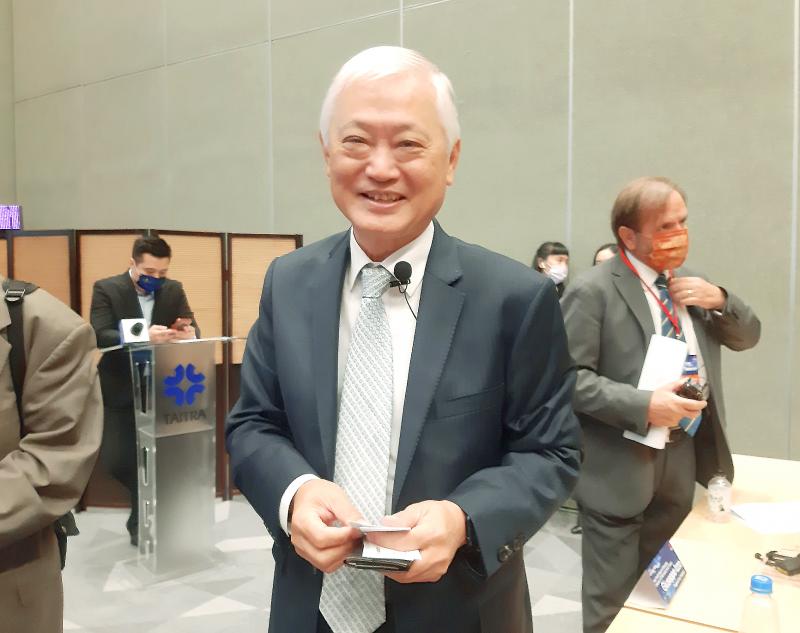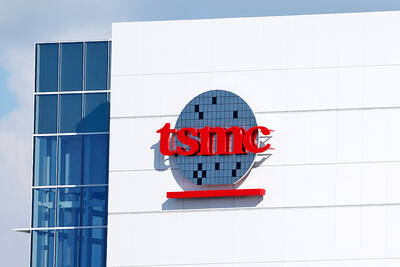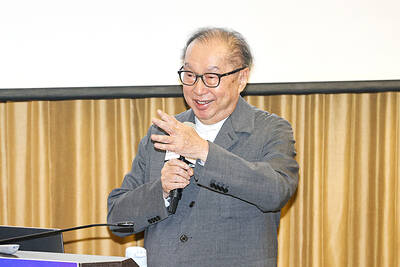Tatung Co (大同) is planning to enter the electric vehicle (EV) software and hardware design business, Tatung president Chaney Ho (何春盛) said at an electro mobility trade show in Taipei yesterday.
The company has long been a maker of EV components, especially motors, and is planning to expand the branch and offer powertrain solutions, especially for buses, Ho said.
“Tatung has been a partner for EV motors since 2006, but we lacked a complete powertrain solution,” he said. “Our collaboration with the Industrial Technology Research Institute (工研院) to develop a powertrain is bearing fruit, and we already have orders for our 250-kilowatt (kW) powertrain.”

Photo: CNA
The company is also developing a 330kW powertrain, he added.
Tatung is eyeing EV buses as an initial market for the company’s products, Ho said.
While the Taiwanese market is small, with about 16,000 units sold per year, global demand for electric buses is at least 2 million units per year, he said.
Tatung would use the Taiwanese market as a springboard for its global ambitions, he said.
It is also planning to combine its to-be-developed powertrain with a bus chassis and export the technology, he said.
“Next year we hope to mass-produce our 330kW powertrain and design it into commercial logistics vehicles,” Ho said.
Tatung is also planning to expand into EV software and hardware design, Ho said.
However, Ho said he is cautious about the prospect of mass production in Taiwan.
The company might instead focus on developing components domestically and assemble the vehicles somewhere else, for example in Southeast Asia, he said.
“It would also be a good opportunity for us to strategically strengthen our presence in Southeast Asian countries,” he said.

SEASONAL WEAKNESS: The combined revenue of the top 10 foundries fell 5.4%, but rush orders and China’s subsidies partially offset slowing demand Taiwan Semiconductor Manufacturing Co (TSMC, 台積電) further solidified its dominance in the global wafer foundry business in the first quarter of this year, remaining far ahead of its closest rival, Samsung Electronics Co, TrendForce Corp (集邦科技) said yesterday. TSMC posted US$25.52 billion in sales in the January-to-March period, down 5 percent from the previous quarter, but its market share rose from 67.1 percent the previous quarter to 67.6 percent, TrendForce said in a report. While smartphone-related wafer shipments declined in the first quarter due to seasonal factors, solid demand for artificial intelligence (AI) and high-performance computing (HPC) devices and urgent TV-related orders

BYPASSING CHINA TARIFFS: In the first five months of this year, Foxconn sent US$4.4bn of iPhones to the US from India, compared with US$3.7bn in the whole of last year Nearly all the iPhones exported by Foxconn Technology Group (富士康科技集團) from India went to the US between March and last month, customs data showed, far above last year’s average of 50 percent and a clear sign of Apple Inc’s efforts to bypass high US tariffs imposed on China. The numbers, being reported by Reuters for the first time, show that Apple has realigned its India exports to almost exclusively serve the US market, when previously the devices were more widely distributed to nations including the Netherlands and the Czech Republic. During March to last month, Foxconn, known as Hon Hai Precision Industry

Taiwan Semiconductor Manufacturing Co (TSMC, 台積電) and the University of Tokyo (UTokyo) yesterday announced the launch of the TSMC-UTokyo Lab to promote advanced semiconductor research, education and talent development. The lab is TSMC’s first laboratory collaboration with a university outside Taiwan, the company said in a statement. The lab would leverage “the extensive knowledge, experience, and creativity” of both institutions, the company said. It is located in the Asano Section of UTokyo’s Hongo, Tokyo, campus and would be managed by UTokyo faculty, guided by directors from UTokyo and TSMC, the company said. TSMC began working with UTokyo in 2019, resulting in 21 research projects,

Quanta Computer Inc (廣達) chairman Barry Lam (林百里) yesterday expressed a downbeat view about the prospects of humanoid robots, given high manufacturing costs and a lack of target customers. Despite rising demand and high expectations for humanoid robots, high research-and-development costs and uncertain profitability remain major concerns, Lam told reporters following the company’s annual shareholders’ meeting in Taoyuan. “Since it seems a bit unworthy to use such high-cost robots to do household chores, I believe robots designed for specific purposes would be more valuable and present a better business opportunity,” Lam said Instead of investing in humanoid robots, Quanta has opted to invest